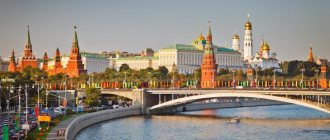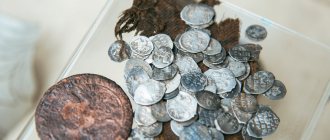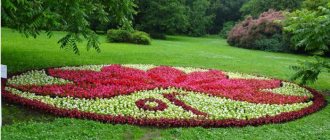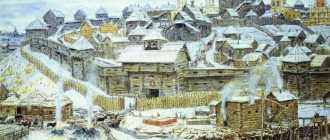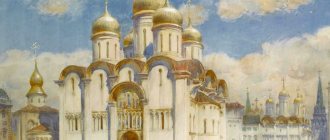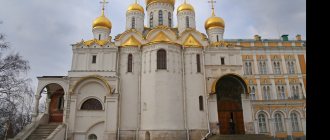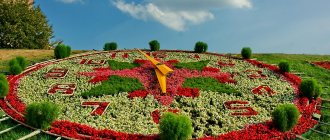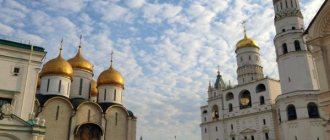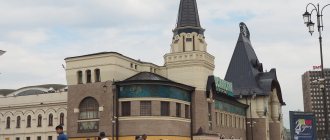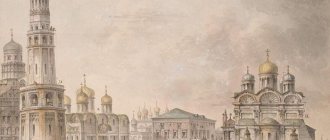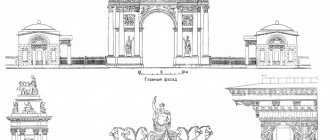Creation of Moscow
The history of the city begins in 1147. This year is officially recognized as the founding year. Very little is known about the settlements that were located on these lands earlier. In 1147, Yuri Dolgoruky invited his ally Svyatoslav Olegovich to a council at the Moscow River. However, some researchers claim that the history of Moscow begins in 1153. According to this version, it was founded not by Yuri Dolgoruky, but by his son Andrei.
At the very beginning of its existence, the city, which later became the Russian capital, was a small border military post of the Suzdal principality. However with great potential. It was here, on the territory of the center of modern Moscow, that the borders of the Seversky, Ryazan, Novgorod, Suzdal, and Smolensk principalities were located. Major waterways crossed here. Moscow at that time was surrounded by dense forests.
Memory of Moscow lands
Archaeological excavations show that the territory of modern Moscow and the Moscow region has been inhabited since ancient times.
The earliest finds - stone and bone axes, knives, fishhooks and arrowheads - traces of the so-called Lyalovo culture - are attributed by experts to the Neolithic era (the later period of the Stone Age). For example, on the territory of the village of Dyakovo (now the Kolomenskoye Museum-Reserve), a primitive site dating back to the 4th millennium BC was discovered [1], and in the Orekhovo-Zuevsky district - almost a thousand years older [2]. The Fatyanovo culture marks the transition to the development of metal. In the Moscow region, for example in Istra and Iksha, archaeologists have studied many burial grounds (burials) from the end of the 3rd millennium BC. Thus, it became known that nomadic herders lived here, who used tools and jewelry made of bronze [1].
Obvious signs of sedentary life are demonstrated by the monuments of the Dyakovo culture, which archaeologists date back more than a thousand years - from the 7th century BC to the 7th-8th centuries AD. The bones of domestic animals, iron sickles and grain graters indicate that Finno-Ugric tribes, such as the Merya and Ves, were actively engaged in agriculture and cattle breeding [1].
Finally, scientists attribute the earthen mounds of the 10th–11th centuries to the Slavic tribes: on the lands of modern Moscow the Vyatichi lived mainly, and in the north of the present Moscow region, above Klyazma, the Krivichi [1].
Traces of Slavic settlements are found in almost all areas with access to water: Dyakovo, Fili, Kuntsevo, Matveevsky, Brateev, Zyuzin... The oldest Moscow house is considered to be the dwelling of a Vyatichi artisan, discovered near the modern Patriarchal Chambers of the Kremlin [1]. It was probably part of a complex of buildings surrounded by a triangular ditch, which was filled in at the beginning of the 12th century. Archaeologists discovered its outline near the current Grand Kremlin Palace [2].
Referring to chronicles and legends, some historians even list the names of Vyatichi settlements, in which the names of such modern districts as Vorobyovo, Vysotskoye, Kulishki, Kudrino, Simonovo, Sushchevo are recognizable.
Vladimir Kuchko
The early period of Moscow's history is shrouded in all sorts of traditions and legends. Once upon a time, not far from the Kremlin there were villages that belonged to the boyar Kuchko. This man was killed by Yuri Dolgoruky. For what? History does not give clear answers to this question.
Moscow is based on a hill, and it was in such places that medieval people preferred to build fortresses. Perhaps Yuri Dolgoruky liked these lands and decided to get rid of the boyar. However, according to legend, the prince ordered Kuchko to be executed for unacceptable rudeness, which, however, did not prevent him from later marrying his son to the daughter of the murdered boyar.
The name "Moscow" appeared later. For some time the city was called Kuchkov. The name of the city is presumably of Finnish origin. Linguists offer several translation options: “cloudy”, “currant”, “twisted”.
Komi tribes
But if we turn to the Komi language, we can easily translate the particle “mosk”, which will mean “cow” or “heifer”. Similar names are often found in world toponymy, for example, the German Oxenfurt or the British Oxford have a literal translation that sounds like “bull ford”. This hypothesis, indicating the origin of the name of the city of Moscow, was supported by the talented and famous Russian historian V. O. Klyuchevsky. It was after his recognition of the viability of this version that the assumption gained particular popularity.
But after careful analysis, it was found that the Komi peoples never lived near the banks of the Moscow River. The theory was subjected to serious and constructive criticism after it was proven that between the Moscow and Ural areas of rivers ending with the prefix “va”, no similar names are found for many thousands of kilometers.
Moscow was not built in a day
Yuri Dolgoruky founded the city, and then left for Kyiv, where he died in 1157. For the next two centuries, no important events took place in the history of Moscow. The development of the city was very slow. Several generations of Dolgorukov's descendants passed before this settlement acquired significance in Vladimir-Suzdal Rus'.
The princely table in Moscow was established in the first half of the 13th century. Alexander Nevsky handed over the city to his son Daniil. A new period has begun in the history of Moscow.
In 1319, Daniel moved to Novgorod. He handed over the Moscow princely throne to his brother Ivan Kalita - a reasonable, pious, but at the same time cruel and calculating man. This prince is an important figure in the history of Moscow. After all, it was he who in the 14th century brought the city to a new level, putting it on par with the largest settlements of that time. Moscow's status has approached Vladimir and Kyiv.
Meryan origin
Scientists continued to search for even the slightest hint of the origin of the name “Moscow”. The main task was to decipher the particle “mosk”, which the famous geographer S.K. Kuznetsov also worked on. The researcher was fluent in several languages belonging to the Finno-Ugric language group. He suggested that the particle “mosk” is of Meryan origin and in the original sounds like “mask”. This word is interpreted in Russian as “bear”, and the prefix “va” is the Meryan word “ava”, which is translated as “wife”, “mother”. Thus, the Moscow River is the “Bear” or “Bear River”. Some historical facts indicate that this version of the origin of the name of Moscow has a right to exist. After all, tribes of the Merya people really lived here, as evidenced by the ancient Russian chronicle “The Tale of Bygone Years.” But this assumption can also be questioned.
This hypothesis, which points to the history of the name “Moscow,” is not supported by the fact that the word “mask” has Mordovian-Erzya and Mari roots. These languages appeared on the territory of our state only in the XIV-XV centuries. The word was borrowed from the Slavic peoples and originally sounded like “mechka” (bear). Also, many questions are raised by the lack of hydronyms ending in “va” in the Moscow region (except for the Moscow River). After all, historical facts indicate that the peoples who lived in a particular territory leave behind many similar toponyms. For example, in the Vladimir and Ryazan regions there are a number of rivers whose names end in “ur” and “us”: Tynus, Kistrus, Bachur, Dardur, Ninur, etc.
Fires and destruction
In 1326, the residence of the Metropolitan of the Russian Orthodox Church was moved from Vladimir to the future Russian capital. This is another important event in the history of the city of Moscow. The following years were not easy. First, the troops of Dmitry Donskoy had to defend the city from the attack of the Lithuanian prince Olgerd. In 1238, Moscow was ravaged by Batu Khan. Thirty years later there was a fire that destroyed almost the entire city. In 1380, as is known, a significant battle took place on the Kulikovo Field. This event also affected the history of the city of Moscow. Rus' freed itself from the Tatar-Mongol yoke. But Khan Tokhtamysh managed to capture Moscow by deception, destroy a large number of local residents and burn the Kremlin.
The city often burned. Fires occurred even after the Russian people learned to use a more reliable material in construction than wood. For example, in 1812. However, the first durable buildings on the territory of the Kremlin appeared thanks to the Italians. The Russians had no problem with stone, and Ivan III invited overseas craftsmen to Moscow.
Foundation of Moscow
The Ipatiev Chronicle says that during the internecine wars of the princes for the possession of the Kiev grand princely throne in 1147, the son of Vladimir Monomakh, the Suzdal prince Yuri, nicknamed Dolgoruky, returning from a campaign against Novgorod, sent an invitation to his relative and ally, the Chernigov-Seversk prince Svyatoslav Olgovich arrive at the military council: “Come to me, brother, in Moscow!” This is how the ancient name of Moscow (“Moskov”) first appeared on the pages of chronicles.
On April 4, 1147, the princes and their squads met in Moscow. Here they held a council, and Yuri, according to the chronicler, gave his guest “a strong lunch.” The official age of Moscow is considered to be based on the chronicle mention of 1147. This is done not only in relation to Moscow. Many cities in the world have their roots in ancient times, and it is impossible to accurately determine their age. Then they count conventionally from the first written mention.
For example, the age of Paris is calculated from the mention in the “Notes on the Gallic War” of Julius Caesar (52-51 BC) of the capital of the Gallic tribe of Parisians, Lutetia.
The chronicler's note we cited does not at all say that Moscow was founded on the day or year of the meeting of the princes. On the contrary, from this record one can rather conclude that in 1147 it already existed and was quite large. Apparently, it was possible to quarter squads of princes here and find sufficient food supplies for a “strong lunch.”
For a long time, inquisitive people have been trying to lift the veil hiding the distant past of our city. The beginning of Moscow is surrounded by legends created at least several centuries ago. Each of them tries in its own way to explain the emergence of the capital, to outline the circumstances under which it fell into the hands of the Rurik princes. In these legends there are various names of the “founders” of Moscow: the legendary Prince Mosoh, the grandson of Noah, from whose name, combined with the name of his wife Kva, the legend gives the name of Moscow; princes Oleg “the prophetic” and Andrei Alexandrovich; finally, boyar Stefan Kuchka. The legends seem to point to different times and places where the first town was founded. But they all agree that Moscow did not arise out of nowhere, that before it there were many settlements in this area.
Boyar Kuchka
Scientists consider the most noteworthy group of legends about the beginning of Moscow, according to which, before Yuri Dolgoruky, Moscow belonged to “no one rich boyar named Kuchko Stefan Ivanov.” A strong and proud boyar, according to legend, was executed by Prince Yuri Dolgoruky for disobedience. The prince ordered the children of Kuchka to be sent to Vladimir, and he himself, “having climbed the mountain and surveyed with his eyes this and the ovamo on both sides of the Moscow River and beyond the Neglinnaya, loved the village thereof, and commanded on that spot to soon build a small ancient city and nickname it the name of the river is that Moscow is a city named after the river flowing under it.” So the author of the tale, apparently without wanting it himself, showed the true goal that the prince pursued - to take the boyar villages and firmly establish himself in this region.
What made researchers single out this particular legend from other legends about the beginning of Moscow? The fact is that the chronicles, telling about the murder of Yuri Dolgoruky’s son, Andrei Bogolyubsky, in 1174, claim that the boyars’ conspiracy against Andrei was led by Yakim Kuchkovich and Peter, Kuchkov’s son-in-law. In another place, the chronicler calls Moscow Kuchkovo - “Moscow, reksha (that is) Kuchkovo.” Chronicles several times in the 14th-15th centuries call one of the Moscow tracts (in the area of modern Sretensky Gates and Chistye Prudy) the Kuchkovo field, that is, the Kuchka field. For Russian people in the 12th century and another two or three centuries later, Kuchka was a very real person . If written sources do not mention Kuchka himself, then they know his children and his son-in-law, his field and even his possession of Kuchkovo, that is, Moscow. Let us add that in the Vladimir region, until the beginning of this century, a legend was preserved that in the Floating Lake near Vladimir the Kuchkovichs were floating in oak boxes, killed for treachery by Vsevolod the Big Nest (brother of Andrei Bogolyubsky), who took the Vladimir grand-ducal throne shortly after the murder of Andrei.
All these facts taken together establish a connection between folk tales and reality. Let us remember that by the end of the 11th - beginning of the 12th century, permanent leaders appeared among the Vyatichi, a feudal nobility was formed that seized the lands of their fellow tribesmen. She, of course, was the main opponent of the spread of the power of the Rurik dynasty and, in particular, the power of Yuri Dolgoruky in the Moscow region. And he, in turn, was not averse to taking over the rich boyar possessions. And the natural ally of the prince in this struggle was the urban population, for whom, as is known, central power was a lesser evil compared to the unbridled rule of the local nobility. The tragic episodes of the struggle of the princes with the local boyars are the bloody events: the murder of Kuchka by Yuri Dolgoruky and the murder of Yuri’s son Andrei by the boyars, led by Kuchka’s son and son-in-law. In the light of everything stated above, it seems to us that M. N. Tikhomirov’s conclusion is quite justified that Kuchka existed in reality and was one of the Vyatic elders and that the villages of Kuchka are a historical reality.
Wooden Kremlin
We have very little information about the oldest Moscow fortifications. One of the first fortifications known to us was a moat that separated the extreme, southwestern part of the Kremlin hill, so that the Church of the Savior on Bor was already behind the moat. However, this ditch was only marked, but not studied by archaeologists (after all, all this happened more than a hundred years ago!). Only in 1960 was it possible to reopen a small section of this ditch. The ditch ran from southeast to northwest, protecting a very small tip of the cape of the Kremlin Hill. Its depth was about 5 meters, width at the top - 12-14 meters.
Some scientists believe that the moat is part of the fortifications built in 1156, while others think that these fortifications must occupy a large area. It is more likely that the ancient ditch was protection for the inhabitants of the first village that existed before Yuri Dolgoruky. It is unlikely that this not very significant village could have fortifications built using the latest technology of that time, with towns. Rather, there was only a ditch, a rampart and a palisade. But these, of course, are only assumptions with which we have to be content until a more complete archaeological study of the Kremlin.
Whoever built the “city of Moscow” in 1156—Yuri Dolgoruky or his son Andrei—princely (or rather Vladimir or Suzdal) master city workers had to directly supervise the work. Since the fortress was now given great military-strategic importance, we can now with good reason think that real towns were built here on an earthen rampart, with a deeper and wider ditch. I. E. Zabelin’s assumption that the new fortress should have been larger than the old one and occupied an area approximately limited by a triangle, the apex of which lay in the extreme southwestern part of the cape, at the confluence of the Neglinnaya with the Moscow River, and its sides had the length approximately 400 meters each (that is, the total length of the walls could be about 1200 meters). But no one has yet found even traces of this fortress.
The remains of wooden-earth fortifications discovered during excavations in 1959 have not yet been sufficiently studied. Now we can only say that this wall reached almost to the modern Trinity Gate of the Kremlin, that it no longer went along the top, but went down a little down the hillside in the direction of Neglinnaya. Its design was somewhat different from the well-known earthen ramparts with towns on top. The base and slope of the shaft were strengthened in an original way - with rows of logs lying on peculiar wooden hooks, which prevented them from moving away from the pressure of the earth. Similar structures were recently opened in Novgorod. They, according to researcher M. X. Aleshkovsky, belong to a Novgorod detin of the early 12th century. There are similar buildings in Polish cities of the 10th-12th centuries. The exposed remains of the Kremlin fortifications apparently date back to the second half of the 12th or the beginning of the 13th century.
The wooden and earthen fortifications of the Moscow Kremlin were stormed by enemies more than once. We know from the chronicles that the city already experienced raids and sieges in the 12th century, and that it was completely destroyed in the 13th century by hordes of Tatars. Of course, after all these events, the fortress walls had to be repaired, restored, and rebuilt in accordance with the requirements of developing siege technology. Apparently, the Moscow mayors were not idle. But only parts of some of the fortifications they built have reached us. Thus, it is known that in 1339 the Moscow prince Ivan Kalita decided to build (presumably with the help of his own Moscow mayors) new fortifications of the Kremlin from oak. During excavation work in the Kremlin, the remains of these walls were discovered - huge oak logs reaching 70 centimeters in diameter. For the first time, it was possible to find part of the tower’s frame. The ends of the logs were no longer fastened “in a claw” (or “with a remainder,” as modern carpenters call such a fastening), but “in a paw with a tooth.” Based on the preserved corner, it could be established that the tower was octagonal.
Over time, the towers began to play an increasingly important role in the defense of the city. They protected not only the gates, but also other parts of the walls, protruding beyond their line in such a way that from the tower it was possible to hit the enemy who approached directly to the very base of the walls. The oak walls of the Moscow Kremlin, built in 1339, judging by the surviving remains, no longer consisted of separate log buildings - gorodens, but formed a continuous line from tower to tower. This more advanced design of wooden-earth fortifications in Rus' was called “taras”. The total length of these new walls was about 1,700 meters. From the side of modern Red Square they were protected by a deep ditch.
The “city” of Kalita existed, however, for less than thirty years. At that alarming time, terrible fires devastated Moscow and, of course, damaged the fortifications. And military technology, which had made great strides forward, required the construction of other, more advanced structures. The political situation also required reliable protection of the capital of the young Russian state. At that time, Moscow had to fight on several fronts - with the Golden Horde, Ryazan, Tver, Lithuania. And in this struggle, the goal of which was to unite the scattered Russian principalities and overthrow the hated Tatar yoke, the defense of the capital became especially important.
White stone Kremlin
Already in 1366, chroniclers recorded that Prince Dmitry Ivanovich (who later received the glorious nickname Donskoy for the victory over the Tatars on the Kulikovo field) with his cousin and co-owner of the city, Prince Vladimir Andreevich, “and with all the elder boyars, they decided to build the city of Kamen Moscow and even planned it.” and create. The same winter brought stones to the city...” “And they began to bring other Russian princes to their will, and those who began to disobey, began to punish them.” Thus, contemporaries already connected the new construction of the Kremlin with the unifying tendencies of Moscow politics.
The new fortress was built using the latest technology. It was a huge structure at that time, occupying almost the entire territory of the modern Kremlin. The total length of the walls reached almost 2 thousand meters. Along this stretch there were eight or nine towers, including five with gates. Construction was completed in 1367 , that is, in one winter and one summer. Enormous amounts of labor were required to extract stone in such a short time from the Myachkovo quarries (about 50 kilometers from the city), bring it across the ice of the river on a sleigh to the construction site, trim it, dig trenches for the foundation along the line of the future walls, prepare lime mortar, lay out the foundation, walls and towers on this mortar, make wooden coverings and “fences” on them. The technique of stone construction itself was still new for Moscow city builders.
Let us remember that the Soviet archaeologist N.N. Voronin calculated approximately how many workers were required to build the fortress. He proceeded from the productivity of labor, which was fixed for each of these works by the “Task Regulations” at the end of the 19th and beginning of the 20th centuries, when construction was still little mechanized. The obtained figures give an idea of the scale of construction, and partly of how the work could be organized. It turned out that for the foundations of the walls and towers (not to mention the external ditch), it was necessary to dig approximately 17,600 cubic meters of earth, lay out about 54 thousand cubic meters of white stone masonry (including more than 14 thousand cubic meters of facing, where each stone was carefully trimmed and fitted to its neighbors) . Just to transport stone from the quarries to Moscow (and the total weight of the stone was approximately 112.5 thousand tons), 4,560 carts had to work continuously for four months. If these carts moved in one continuous convoy, one after the other, they would stretch for 20.5 kilometers. During the summer construction season of 1367 (about 168 days), 1,970 people must have worked daily on the main construction work alone. And if we consider that in the 14th century, under feudal production relations, when the overwhelming majority of workers were forced people, labor productivity could not be the same as in the 19th-20th centuries, then this figure needs to be increased further. In construction work in Moscow in 1367, more than 2 thousand people were employed daily, driven from many (sometimes remote) places. They worked under the guidance of Moscow mayors. One might think that Moscow boyars also took part in this grandiose construction for that time.
The chronicle connects the very beginning of construction with the decision of some council of princes and “oldest” boyars. The ancient names of some towers - Cheshkova (later Tainitskaya), Timofeevskaya (later Konstantino-Eleninskaya) - come from the names of the Moscow boyars Danil Cheshka and Timofey Vorontsov-Velyaminov. Historians believe that these names were given because the courtyards of these boyars were located nearby. But in the feudal cities of Western Europe there was an ancient custom according to which noble families were supposed to participate in the construction and defense of fortification sites located near their homes. Russian charters, which defined the military duties of the boyars, emphasized that the boyars should serve the “city siege” “where anyone lives.” Perhaps the very names of the towers of the Moscow Kremlin were given in connection with this responsibility, and not just in the neighborhood.
The very location of the towers of the new Kremlin is interesting. More than half of them - five - defended the eastern wall, from the side of what is now Red Square. This is natural, because it was on this side that the Kremlin was deprived of natural barriers - the Neglinnaya and Moskva rivers with their steep banks and impassable swampy floodplains. This is where the main danger threatened. But it is surprising that it was on this “approach” wall that three of the five towers were passable, and it is easier for the enemy to storm the gates, even if they are iron, than blank walls and towers. However, lively communication with other parts of the city and free access to long-distance roads were apparently so important that the city builders deliberately allowed some weakening of the defensive capacity of this line of fortifications. They must have counted on an active defense of the fortress, with frequent forays, in which the abundance of ways out of a disadvantage turns into an advantage for the defenders.
Built in 1367, the Kremlin had the most modern weapons; there were even firearms on its walls and towers. This fortress withstood many sieges. She was never taken by assault. It is known that already in the first years after the construction of the white-stone Kremlin, the Lithuanian prince Olgerd unsuccessfully besieged it twice. And in 1382, when Moscow suffered one of the worst devastations in its centuries-old history, the Tatar attack on the Kremlin was repulsed, and only by deception Tokhtamysh managed to break into the gates opened by the defenders.
The white stone Kremlin of Dmitry Donskoy served for more than a hundred years. It survived sieges, fires, and even an earthquake. The fortress was built up in height and generally seriously “renovated” by Moscow city workers, among whom we meet the famous Moscow architect Vasily Dmitrievich Ermolin, who led a large group of city builders. On the Frolovsky (now Spassky) gates of the Kremlin, V.D. Ermolin placed carved stone figures. One of them is the figure of St. Dmitry Selunsky, in whose honor Dmitry Ivanovich Donskoy was named. The other figure is the coat of arms of the city of Moscow. This is a horseman with a spear, a “rider”, who only much later began to be conceptualized as Saint George the Victorious. The surviving part of the horseman’s figure, which long adorned the Frolov Gate, can now be seen in the Tretyakov Gallery.
Sometimes wooden forts were erected in place of the destroyed parts of the stone wall. The number of such repairs increased over the years, and by the second half of the 15th century it was already so great that to the foreigner Ambrose Contarini the Moscow Kremlin seemed entirely wooden.
Brick Kremlin
At the end of the 15th century, the need arose to build a new fortress in the center of Moscow. There is no need to explain that this need was caused primarily by the increased role of Moscow as the capital of the centralized Russian state, and then, of course, by the dilapidation of the old fortress.
By that time, the greatly expanded city already had external fortifications. These were both ancient monastery forts and later wooden-earth fortifications. Thus, along the line of modern Bolshoi Cherkassky Lane back in the 14th century there was a ditch and a rampart. Later, in more significant areas - from Kuchkovo Pole to the mouth of the Yauza and in Zaneglimenye, in the area of modern Suvorovsky and Gogolevsky boulevards, fortification lines were also built. They are still poorly studied. One can only assume that the design of the fortress was similar to the ancient one - ditches and earthen ramparts with fortresses or taras, and in some places just a palisade. Significant sections of these outer fortifications were never completed.
Construction of the new Kremlin took more than ten years. With short breaks, from 1485 to 1495, walls and main towers were built. By 1499, the internal fortifications that directly protected the princely court were completed. All work on the construction of the new defense system was completed only in 1516.
There is no need to describe the new Kremlin in detail - we see it now. These are the same walls and towers that rise in the center of Moscow. But, of course, in the 15th century the towers did not yet have magnificent multi-tiered superstructures with hipped roofs, which were built only in the 17th century. The territory of the Kremlin was somewhat expanded. Its northern corner was pushed further towards Neglinnaya, and the southwestern corner - towards the Moscow River. Abundant springs flowed here, reliably providing the fortress with fresh water in case of a long siege. The entire western line of the walls was moved to the west and lowered down to the bank of the Neglinnaya River.
The new walls of the Kremlin were made of brick and completed with battlements, which reliably covered the defenders of the fortress. The total length of the walls is approximately 2,250 meters, thickness from 3.5 to 4.5 m, height - depending on the terrain - from 5 to 19 meters. The towers of the fortress were located so that there were seven towers on each side of the irregular triangle that represents the Kremlin (including the corner ones). Thus, the north-eastern side of the Kremlin was defended by the Sobakin (now Corner Arsenal), Nikolskaya, Senate, Frolovskaya (now Spasskaya), Nabatnaya, Konstantino-Eleninskaya (formerly Timofeevskaya) and Beklemishevskaya (or Moskvoretskaya) towers. Southern (from the side of the Moscow River) - Beklemishevskaya, Petrovskaya, 1st and 2nd Nameless, Tainitskaya (formerly Meshkova), Blagoveshchenskaya, Sviblova (or Vodovzvodnaya) towers. Finally, from the Neglinnaya side - Sviblova, Borovitskaya, Oruzheynaya, Komendantskaya, Troitskaya, Middle Arsenalnaya and again Sobakina towers.
The Kremlin was covered on both sides by the Moscow and Neglinnaya rivers. In 1508, it was turned into a real island by a moat dug along modern Red Square, approximately along the line where the stands are now located. The width of this grandiose ditch was 34-35 meters, the depth was about 8 meters. Both banks ended with the battlements of the same truss as on the Kremlin walls. In 1516, hydraulic engineering work on Neglinnaya was completed, as a result of which the wide expanse of water of the Neglinnaya ponds was formed in front of the Kremlin.
All the enormous construction work in the Kremlin was, of course, carried out by Moscow mayors. They were led by masters Marco Ruffo, Pietro Antonio Solario, invited from Italy, and later by Aleviz. On the Spasskaya Tower you can still see inscriptions carved on white stone slabs: on the outside in Latin, and on the inside, above the gate passage, in Russian. It is written in beautiful script: “In the summer of 6999 (according to modern chronology - 1491) July, by the grace of God this archer was made by the command of John Vasilyevich, sovereign and autocrat of all Rus' and the Grand Duke of Volodymyr and Moscow and Novgorod and Pskov and Tver and Yugorsk and Vyatka and Perm and the Bulgarian and others in the 30th year of his reign were made by Peter Anthony from the city of Mediolan.”
The participation of boyar and merchant families in the construction of the Kremlin is indicated by the names of the Beklemishevskaya, Sviblova and Sobakina towers. The Sviblos and Beklemishevs were old Moscow boyar families, and the Sobakins were large Novgorod merchants, recently “transferred” to Moscow after Novgorod annexed it.
What is Kutafya?
There were six gates in the Kremlin. Three passage towers - Nikolskaya, Spasskaya and Konstantino-Eleninskaya - overlooked the most important roads to the east and southeast. Back in 1380, the army of Dmitry Ivanovich came out of the three gates of the Kremlin onto these roads in three columns, heading to Kolomna, and then to the Don on the Kulikovo field. The Tainitsky gates overlooked the Moscow River, and the Borovitsky and Troitsky gates opened onto Neglinnaya and further onto roads going to the west and north-west. All of these towers (of course, except Taynitskaya) had bridges spanning the moat or Neglinnaya. And on the opposite bank of the Kremlin there were bridgeheads. Only one of them, at the Trinity Gate, has survived to this day, bearing a somewhat strange name - Kutafya Tower . The name is usually explained by the fact that the tower is low and squat, hence the word “kutafya”. This is how in some Russian dialects they called an overly wrapped woman. And the word “kutafya” comes from the verb “to wrap”.
There are other options for the origin of the name of the Kutafya tower. In Russian, this word also has another meaning - “to lock, close.” For example, in many places in Russia even now they will tell you to wrap up the stove, which means “to close the stove damper.” The name Kutafya Tower is associated with this meaning of the verb “kutat”. After all, it was precisely what locked and closed the approach to the permanent road bridge to the Kremlin, which was built, of course, as a fortress capable of withstanding a long siege.
Archaeological excavations carried out in 1956 showed that previously the exit from Kutafya was not where it is now. Then we left the tower to the north, along the bank of the Neglinnaya River, where the Alexander Garden is now, perpendicular to the line of the bridge that connected Kutafya with the Trinity Tower. On this side of Kutafya, two narrow cracks are still visible, into which the chains of the drawbridge once passed. But why could there be a drawbridge here if the river was already behind, and Kutafya did not have an additional ditch? During the excavations, it turned out that the thick layer of earth lying directly under the modern asphalt pavement was partially washed out by the Neglinnaya River, and partially poured during various works. At the time when Kutafya was built, the river bank was much lower, and the roadway of the tower gate was about 6 meters above the then ground level. Kutafya had a powerful base that extended from the passage of the gate, expanding in a cone shape to the very ground. It is clear that it was possible to move down to the ground from this gate or enter the gate from the shore only along an inclined bridge. Closer to the tower was its lifting part, which, if necessary, was pulled up using winches and closed the gate.
Thus, the plan of the mayors was very cunning. Entry into the fortress was extremely difficult for the enemy. To penetrate the Kremlin, the enemy had to first climb a light bridge to a height of 6 meters. But at the gate the bridge turned out to be raised, and a wide opening six meters deep again separated the enemy from the bridgehead. But even if it were possible to somehow overcome this obstacle and break into the gate, it would turn out that the already pretty battered enemy in the cramped tower would have to turn at a right angle to the left and storm the new gate, undoubtedly under fire from the defenders of the fortress from the top platform of the tower. The situation, to be sure, is unenviable.
The drawbridge at Kutafya did not last long. The supports of this bridge, which has not survived, were found in the ground. Moreover, at a depth of 5.5-6 meters from the modern surface of the earth, in the river mud washed up by the river, they found a number of things that fell under the bridge almost 500 years ago and remained there. These are mainly horseshoes that have come off shoes and horse hooves. A leather bag called a wicket was also found. Already in the 16th century, the drawbridge was replaced by a permanent frame with a platform on top, and in the 17th century, an inclined stone ramp. Their remains have also been discovered by archaeologists.
But Kutafya, then, was not short? How then to explain its name? We think that this name goes back to a much earlier time, perhaps even to the 12th-13th centuries, when approximately in this place, on the left bank of the Neglinnaya, there was a “kut”, or corner of an ancient fortress. This name could last a long time and go to the bridgehead, built at the end of the 15th century.
Soon
In an effort to reliably protect their city from the danger of surprise attacks, Muscovites in 1591 erected another line of fortifications, covering the entire territory of Moscow on both banks of the Moscow River. It was a wooden-earth fortress, stretching along the line of modern Garden streets for 15 kilometers. A ditch was dug on its outer side, the remains of which were discovered by archaeologists during the construction of the Smolenskaya metro station. Of the 50 towers of the new fortress, 34 were travelable. The Kaluga and Serpukhov gate towers facing the southern roads were made of stone, the rest, like the entire wall, were wooden frames 7-8 meters wide, filled with earth.
Built in just one year, the new fortress was named Skorodoma. It underwent great trials during the years of the Polish intervention and, as a result of many assaults, by the time the second militia liberated Moscow it was almost completely destroyed. In its place, an “earthen city” was subsequently built - an embankment without gorodens or taras, but with bastions, which were then built throughout Europe to accommodate new, more advanced artillery pieces. By that time, fortress walls and towers had already ceased to play a leading role in the defense of cities.
Ivan III
Moscow became the capital of the Russian state even before this prince came to power. The lands of northeastern Rus' were finally freed from Golden Horde dependence. The Moscow principality gained relative freedom. Ivan III made every effort to turn the city into the Third Rome. After he married Sophia Palaeologus, the niece of the Emperor of Constantinople, the Byzantine double-headed eagle became a symbol of Moscow autocracy. His image appeared on princely seals.
The Russian state needed to be strengthened. The Moscow princes paid great attention to the construction of new structures capable of protecting them from enemy attacks. Under Ivan III, a square appeared, which today is one of the main attractions of the Russian capital and is included in the UNESCO cultural heritage list. But then it was called differently.
Historical demographics
Graphics: population progress
The city's population is growing rapidly. The ubiquitous presence of legal and illegal permanent and temporary migrants plus merging suburbs increases the total population to approximately 13.5 million.[13]
| |||||||||||||||||||||||||
| 1840 | 349 100 | ||||||||||||||||||||||||
| 1852 | 373 800 | ||||||||||||||||||||||||
| 1858 | 336 400 | ||||||||||||||||||||||||
| 1864 | 351 600 | ||||||||||||||||||||||||
| 1868 | 416 400 | ||||||||||||||||||||||||
| 1871 | 601 969 | ||||||||||||||||||||||||
| 1886 | 753 459 | ||||||||||||||||||||||||
| 1891 | 822 400 | ||||||||||||||||||||||||
| 1897 | 1 038 600 | ||||||||||||||||||||||||
| 1900 | 1 175 000 | ||||||||||||||||||||||||
| 1908 | 1 359 200 | ||||||||||||||||||||||||
| 1912 | 1 617 157 |
| 1920 | 1 028 200 |
| 1926 | 2 019 500 |
| 1936 | 3 641 500 |
| 1939 | 4 137 000 |
| 1956 | 4 847 000 |
| 1959 | 5 032 000 |
| 1970 | 6 941 961 |
| 1979 | 7 830 509 |
| 1989 | 8 769 117 |
| 2002 | 10 126 424 |
| 2005 | 10 407 000 |
| 2012 | 11 500 000 |
Red Square
Initially it was called Torg. This square in the 16th century had little in common with the historical landmark visited by millions of tourists every year. It became stone only in the 19th century, and before that it was wooden, which is why it burned so often. For some time the square was even called the Fire.
During the time of Ivan III, shopping arcades appeared on the square. There is brisk trade here today. But in the Middle Ages, on the main Moscow square, they sold not expensive souvenirs to tourists from Europe and America, but more practical products to local residents. In the 17th century, a decree was issued to demolish the shops. The traders ignored him, and only after Peter the Great took tough measures did they move outside the square.
St. Basil's Cathedral
The construction of churches became of great importance in the history of Moscow. The Orthodox Church needed to justify the title of successor to Byzantium, and it coped with this task perfectly. Satrap Ivan IV did not spare money from the state treasury for the construction of new churches. He ordered St. Basil's Cathedral, one of the main attractions of Moscow today, to be built in honor of the victory in the Kazakh campaign.
The names of the architects according to whose design the temple was erected became known only in the 19th century. Barma and Postnik are the names of the masters, thanks to whom one of the most beautiful Orthodox churches in the world has stood on Red Square for more than five hundred years. True, the French Architect Le Corbusier, who visited the Russian capital in the 20th century, called the cathedral “the delirium of a drunken pastry chef.”
Ivan groznyj
This ruler played a significant role in the development of Moscow culture. He entered the history of Russia as the first Russian Tsar. In 1547, Metropolitan Macarius proclaimed Ivan IV the Russian autocrat and placed the Monomakh cap, one of the symbols of power, on his head.
The king was a tyrant, but this did not stop him from becoming one of the most educated people of the era. In the 50s he founded the Printing House. He had a huge collection of books for those times. After another mass execution, Ivan the Terrible donated significant sums to monasteries. However, during the years of his reign, many priests and monks died.
Time of Troubles
After the death of Boris Godunov, Moscow rulers were replaced one after another. The city fell into the hands of the Poles. Patriarch Hermogenes stated that if Vladislav Sigismundovich does not accept Orthodoxy, he will have to abdicate the throne. But the Polish prince was not satisfied with such conditions - he was a fanatical Catholic. Then the patriarch sent letters throughout the state calling for the fight for the liberation of Moscow. The militia was led by Dmitry Pozharsky and Kozma Minin. In 1818, a monument was erected to the people's hero on Red Square.
Romanov Dynasty
In 1614, an important event took place for all of Russia - the coronation of Fyodor Mikhailovich, the first of the Romanov dynasty. In the 17th century, as before, fires occurred in Moscow and epidemics flared up. There were no country cemeteries. Muscovites were buried within the city.
One of the most famous cemeteries in the capital, Vagankovskoye, was founded in the 70s of the 18th century in connection with the plague epidemic. Today here are the graves of famous actors, directors, artists, writers, poets, and athletes. This cemetery is associated with a tragic event that occurred on the day of the coronation of the last Russian Tsar. On May 30, 1896, pandemonium broke out on the Khodynka field, leading to numerous casualties. The dead were buried at the Vagankovskoye cemetery. Here in 1896 a monument to the victims of the stampede on Khodynskoye Field was erected.
In 1712, Peter I moved the capital to the newly created city. However, Moscow remained the spiritual and cultural center of Russia even after. During the Patriotic War of 1812, the city was captured by Napoleonic troops. Moscow was heavily damaged by the fire. The fire consumed about 70% of the buildings.
Recommendations
- Robert Argenbright, "Moscow on the Rise: From Primate City to Mega-Region", Geographical Review
(2013) 103 no. 1, p. 20–36. - J. L. I. Fennell, Ivan the Great of Moscow
(1961) 354 pp. - Sergei M. Soloviev and John J. Windhausen, eds. Russian history.
Vol. 8: Russian society in the era of Ivan III (1979) - P.V. Sytin, “From the history of Moscow streets”, M., 1948, p. 296.
- RS. Anderson, Peter the Great
(1978) p.13 - Hecker, Hans (2012). “Shaurig-grand Shauspiel” [A terrifying and terrifying sight]. Damals
(in German). Vol. 44 no. 9. pp. 72–77. - Alexander M. Martin, "Sewerage and the City: Dirt, Smell, and Images of City Life in Moscow, 1770–1880." Russian Review
(2008) 67 #2 pp. 243-274. - Isabelle Wünsche, "Homo Sovieticus: the sporting motif in the design of the Dynamo metro station", Studies in the Decorative Arts
(2000) 7#2 pp. 65-90 - Andrew Jenks, "Subway on the Mountain", Technology and Culture
(2000) 41 #4, pp. 697-723p - Michael Robbins, "London Underground and Moscow Underground", Journal of Transport History,
(1997) 18#1 pp 45-53. - Gordon W. Morrell, "Rethinking Intelligence and Information Collection: The Industrial Intelligence Center and the Metro-Vickers Case, Moscow, 1933." Intelligence and National Security
(1994) 9#3, p. 520-533. - Robert J. Mason and Liliya Nigmatullina, “Suburbanization and Sustainability in Metropolitan Moscow.” Geographical Review
(2011) 101#3 pp 316-333. - Robert Argenbright, "Moscow on the Rise: From Primate City to Mega-Region", Geographical Review
(2013) 103 no. 1, p. 20–36.
Khitrovka
Vladimir Gilyarovsky spoke about what the capital of Russia looked like at the beginning of the 20th century. One of the chapters of the book “Moscow and Muscovites” is called “Khitrovka”. It is dedicated to a terrible area that has become part of the history of Moscow. Crowds of ragamuffins, thieves, and bandits roamed the streets of Khitrovka day and night. To travel through this area meant dooming yourself to meet with robbers and, possibly, losing not only your things, but also your life. Today, on the site of the Khitrovsky shelters there are shops, restaurants, and office centers.
Soviet time
Nine years after the tragedy on the Khodynskoye Field in Moscow, street battles took place. After 12 years, a revolution occurred and the king was overthrown. The new government returned the city to the status of the capital.
In the first half of the 20th century, a huge number of new residential buildings appeared. If in the 20s most Muscovites lived in barracks and communal apartments, then after the war almost all of them received new housing. In addition, new highways were built. True, some of the architectural monuments were demolished during the Soviet years. This is a brief history of Moscow - one of the largest and most disorderly cities in the world.
There are many preserved architectural monuments in the capital. You should start getting acquainted with the city from the Kremlin. Tours are offered here all year round. Rare exhibitions are presented. One of the oldest cultural institutions in the Russian capital is the Moscow History Museum, located near the Park Kultury metro station.
Hybrid version
In the first half of the twentieth century, academician L. S. Berg, based on the Japhetic theory of N. Ya. Marr, put forward the assumption that the root “Mosk” was borrowed from the Moskhi who lived in the Caucasus, and the prefix “va” was taken from the Finno-Ugric language group. However, the scientist was unable to find a single historical fact that would confirm his hypothesis.
